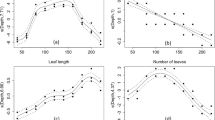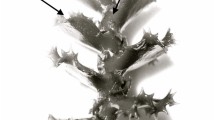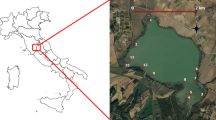Abstract
Submerged macrophytes growing in clear- and turbid water may develop morphological differences as adaptations to difference light levels. Plant forms altered over generations and longtime are regarded as ecotypes and the changes are assumed to be persistent, even if the plants are returned to their ancestral environment. Specimens of Potamogeton malaianus from clear and turbid water zones of Lake Taihu were compared in their native settings and after transplanting to similar and different environments. Results showed that turbid water forms of P. malaianus had significantly larger shoots with more and longer leaves and more biomass concentrated near the water surface. After transplanting into clear water, the daughter shoots arising from clear or turbid water plants showed no significant differences from their mother shoots, but showed significant differences from each other. After transplanting into turbid water, mother and daughter shoots originating from turbid water plants had similar morphologies, but were significantly different from clear water plants. Plants transplanted from clear water did not survive in turbid water. Our results suggest that P. malaianus forms special ecotype in turbid water, which may help plants maximize their sunlight-harvesting potential and thus might contribute to an observed expansion of the species into turbid water areas of eutrophic lakes.





Similar content being viewed by others
References
Adrian, R., D. O. Hessen, T. Blenckner, H. Hillebrand, S. Hilt, E. Jeppesen & D. Trolle, 2016. Environmental impacts lake ecosystems. In Ichtiaque Rasool, S. (ed.), North sea region climate change assessment. Springer International Publishing, Switzerland: 315–340.
Bakker, E. S., E. Van Donk, S. A. J. Declerck, N. R. Helmsing, B. Hidding & B. A. Nolet, 2010. Effect of macrophyte community composition and nutrient enrichment on plant biomass and algal blooms. Basic and Applied Ecology 11(5): 432–439.
Barko, J. W. & R. M. Smart, 1981. Comparative influences of light and temperature on the growth and metabolism of selected submersed freshwater macrophytes. Ecological Monographs 51: 219–236.
Beeton, A. M., 1984. The world’s great lakes. Journal of Great Lakes Research 10(2): 106–113.
Berg, M. P., E. T. Kiers, G. Van Driessen, M. Der Heijden, B. W. Kooi, F. Kuenen, M. Liefting, H. A. Verhoef & J. Ellers, 2010. Adapt or disperse: understanding species persistence in a changing world. Global Change Biology 16: 587–598.
Blindow, I., 1992. Decline of charophytes during eutrophication: comparison with angiosperms. Freshwater Biology 28: 9–14.
Bolnick, D. I., L. K. Snowberg, C. Patenia, W. E. Stutz, T. Ingram & O. L. Lau, 2009. Phenotype-dependent native habitat preference facilitates divergence between Parapatric lake and stream stickleback. Evolution 63: 2004–2016.
Brooker, R. W., 2006. Plant-plant interactions and environmental change. New Phytologist 171: 271–284.
Carignan, R. & J. Kalff, 1980. Phosphorus sources for aquatic weeds: water or sediments? Science 207(4434): 987–989.
Carpenter, S. R. & D. M. Lodge, 1986. Effects of submersed macrophytes on ecosystem processes. Aquatic Botany 26: 341–370.
Carter, V. & N. B. Rybicki, 1990. Light attenuation and submersed macrophyte distribution in the tidal Potomac River and estuary. Estuaries 13: 44.
Duan, H., R. Ma, X. Xu, F. Kong, S. Zhang, W. Kong, J. Hao & L. Shang, 2009. Two-decade reconstruction of algal blooms in China’s Lake Taihu. Environmental Science & Technology 43(10): 3522–3528.
Ebina, J., T. Tsutsui & T. Shirai, 1983. Simultaneous determination of total nitrogen and total phosphorus in water using peroxodisulfate oxidation. Water Research 17(12): 1721–1726.
Goldsborough, W. J. & W. M. Kemp, 1988. Light responses of a submersed macrophyte: implications for survival in turbid tidal waters. Ecology 69: 1775–1786.
Guan, B., S. An & B. Gu, 2011. Assessment of ecosystem health during the past 40 years for Lake Taihu in the Yangtze River Delta, China. Limnology 12(1): 47–53.
Jeppesen, E., M. Søndergaard & K. Christofferson (eds.), 1998. The structuring role of submerged macrophytes in lakes. Springer -Verlag, New York.
Liancourt, Pierre, Laura A. Spence, Daniel S. Song, Ariuntsetseg Lkhagva, Anarmaa Sharkhuu, Bazartseren Boldgiv, Brent R. Helliker, Peter S. Petraitis & Brenda B. Casper, 2013. Plant response to climate change varies with topography, interactions with neighbors, and ecotype. Ecology 94(2): 444–453.
Liu, W. L., W. P. Hu & X. H. Gu, 2007. The biomass variation of Potamogeton malaianus and its influential factors in Lake Taihu. Acta Ecologica Sinica 27(8): 3324–3333.
Ma, R., H. Duan, X. Gu & S. Zhang, 2008. Detecting aquatic vegetation changes in Taihu Lake, China using multi-temporal satellite imagery. Sensors 8: 3988–4005.
McFarland, D. G., J. W. Barko & N. J. McCreary, 1992. Effects of sediment fertility and initial plant density on growth of Hydrilla verticillata (Lf) Royle and Potamogeton nodosus Poiret. Journal of Freshwater Ecology 7(2): 191–200.
Parsons, T. R., 1963. Discussion of spectrophotometric determination of marine-plant pigments with revised equations for ascertaining chlorophylls and carotenoids. Journal of Marine Research 21: 155–163.
Phillips, G., N. Willby & B. Moss, 2016. Submerged macrophyte decline in shallow lakes: what have we learnt in the last forty years? Aquatic Botany 135: 37–45.
Rehman, F., A. Pervez, B. N. Khattak & R. Ahmad, 2016. Constructed wetlands: perspectives of the oxygen released in the rhizosphere of macrophytes. CLEAN–Soil, Air, Water 44(9999): 1–9.
Sayer, C. D., T. A. Davidson & J. I. Jones, 2010. Seasonal dynamics of macrophytes and phytoplankton in shallow lakes: a eutrophication-driven pathway from plants to plankton? Freshwater Biology 55: 500–513.
Schneider, S. C., D. E. Pichler, T. Andersen & A. Melzer, 2015. Light acclimation in submerged macrophytes: the roles of plant elongation, pigmentation and branch orientation differ among Chara species. Aquatic Botany 120: 121–128.
van den Berg, M. S., M. Scheffer, H. Coops & J. Simons, 1998. The role of characean algae in the management of eutrophic shallow lakes. Journal of Phycology 34(5): 750–756.
Zhang, Y., B. Zhang, R. Ma, S. Feng & C. Le, 2007. Optically active substances and their contributions to the underwater light climate in Lake Taihu, a large shallow lake in China. Fundamental and Applied Limnology (Archiv für Hydrobiologie) 170(1): 11–19.
Zhang, Y., K. Shi, X. Liu, Y. Zhou & B. Qin, 2014. Lake topography and wind waves determining seasonal-spatial dynamics of total suspended matter in turbid Lake Taihu, China: assessment using long-term high-resolution MERIS data. PLoS ONE 9(5): e98055.
Zhang, Y., X. Liu, B. Qin, K. Shi, J. Deng & Y. Zhou, 2016. Aquatic vegetation in response to increased eutrophication and degraded light climate in Eastern Lake Taihu: implications for lake ecological restoration. Scientific Reports 6: 23867.
Zhu, G., W. Li, M. Zhang, L. Ni & S. Wang, 2012. Adaptation of submerged macrophytes to both water depth and flood intensity as revealed by their mechanical resistance. Hydrobiologia 696(1): 77–93.
Acknowledgements
This research was financially supported by the National Natural Science Foundation of China (NSFC, Grant Nos. 31100341 and 31270409). We thank the Taihu Lake Ecosystem Field Station for supporting our experiments. We greatly appreciate the comments and suggestions from the reviewers and the editor in charge. We also thank Ms. Amy-Jane Beer very much for polishing the language.
Author information
Authors and Affiliations
Corresponding author
Additional information
Handling editor: Mariana Meerhoff
Rights and permissions
About this article
Cite this article
Guan, B., Wang, X., Yin, C. et al. Comparison of the morphological traits of the submerged macrophyte Potamogeton malaianus from turbid and clear waters in Lake Taihu. Hydrobiologia 813, 63–74 (2018). https://doi.org/10.1007/s10750-018-3509-z
Received:
Revised:
Accepted:
Published:
Issue Date:
DOI: https://doi.org/10.1007/s10750-018-3509-z




